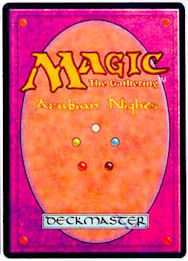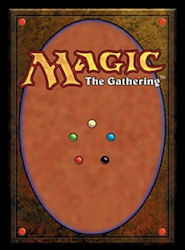Card back




The card back is printed onto the back of each Magic card, except double-faced cards. The back of each card is identical, with exception to those of commemorative sets, and features the Magic: The Gathering logo, a representation of the color wheel and the word "Deckmaster" at the bottom, all on top of a brown background with an oval shape meant to represent the cover of a book (your deck is your "library" of magic spells, obviously kept in some kind of magical tome). It was designed and colored by the original art director for the game, Jesper Myrfors, together with Christopher Rush. [1].
Until the release of double-faced cards, no legal card could have a different print on the back than the regular Magic card back. That's also the reason that the back stayed unchanged during the 8th Edition revision of the card frame.
Different backs
Originally it was planned to feature different backs for Arabian Nights and each following expansion but this was infeasible as people would be able to tell which card they would probably draw next depending on the ratio of cards from each expansion in their decks. [2]
For the Tempest set, design briefly considered creating cards with draw triggers that had different backs so the opponent would see when such a card was drawn. [3]
In 2001 or early 2002 the word "Deckmaster" was almost trademarked without thinking of the ramifications the change would have on the game, namely that players could cheat by using lands that didn't have the extra trademark and spells that did, or vice versa. This was timely recognized and prevented. [4]
On April Fools' 2004 Wizards of the Coast jokingly announced that due a trademark challenge by the Orlando Magic ™ of the National Basketball Association, the name of the game would be changed to Magique: the Gathering. To solve the problem of mixing different card backs for casual and tournament play, the company had decided to run a limited print run of each previously published Magique: the Gathering expansion with the new card back. [5]
Logo
Since the card back cannot change, it features some imperfections as the logo is the older, blue version while everywhere else the logo has been updated for yellow with red trim. After the blue version was locked on the card back, the brand team realized that blue was a poor choice for packaging and advertising. [6]
The only paper cardbacks with the updated yellow logo are the oversized Commander and oversized Planechase cards. The idea is that as long as all the oversized cards have the same back, even if it’s slightly different, it doesn’t matter. [7]
Deckmaster
When Magic was first designed, Wizards of the Coast had plans for a series of trading card games. To group these games together, they were all given the name "Deckmaster". Magic, Jyhad (renamed Vampire: the Eternal Struggle), Netrunner and BattleTech were all Deckmaster games. Wizards of the Coast eventually abandoned this method of grouping their trading card games, but the Magic card back is locked so the Deckmaster logo remains. [8][6]
There are the markings of a ballpoint pen over the 'T' and 'R' in Deckmaster which accidentally were introduced to the logo before the printing. [9][10]
Trademark
One more detail on the back of the card that has changed everywhere but remains the same on the back of the card is the trademark of the logo. Everywhere else the logo is used it now has a registered trademark (an ®) rather than a simple trademark (a ™). At the time of the original printing, the logo didn't yet have a registered trademark. [6]
On the Battlefield
If a permanent on the battlefield is turned face down by a spell or ability, it becomes a 2/2 face-down colorless creature with no text, no name, no subtypes, no expansion symbol, and no mana cost. A card that enters the battlefield face down also has these characteristics.
Double-faced cards
A double-faced card's back face is indicated by the transformation related icon (often the moon symbol) in its upper left corner.
Digital
In the digital Duels of the Planeswalkers, the "Deckmaster" logo has been removed. Also, the Magic: The Gathering logo has been changed from blue to yellow. [11] There are also official card sleeves with this design.
Challenge cards
Challenge cards have different card backs, which indicate that they can't be played in regular decks.
Hero cards and tokens
Hero Cards and tokens both have advertising on their card backs, to indicate that they are to be kept separate from all decks.
References
- ↑ Mark Rosewater (January 27, 2003). "Frames of Reference". magicthegathering.com. Wizards of the Coast.
- ↑ Magic Arcana (August 05, 2002). "Almost a Different Back". magicthegathering.com. Wizards of the Coast.
- ↑ Template:NewRef
- ↑ Magic Arcana (March 26, 2002). "The eternal cardback". magicthegathering.com. Wizards of the Coast.
- ↑ Mark Rosewater (April 1, 2004). "Ask Wizards". magicthegathering.com. Wizards of the Coast.
- ↑ a b c Mark Rosewater (February 16, 2009). "25 Random Things About Magic". magicthegathering.com. Wizards of the Coast.
- ↑ Error on call to {{WebRef}}: Parameters url and title must be specifiedMark Rosewater (April 03, 2012). "". Tumblr.
- ↑ Mark Rosewater (April 29, 2004). "Ask Wizards". magicthegathering.com. Wizards of the Coast.
- ↑ Error on call to {{WebRef}}: Parameters url and title must be specifiedMark Rosewater (April 01, 2012). "". Tumblr.
- ↑ Worth Wollpert (May 22, 2004). "Ask Wizards". magicthegathering.com. Wizards of the Coast.
- ↑ Monty Ashley (August 24, 2012). "The Alternate Back". magicthegathering.com. Wizards of the Coast.